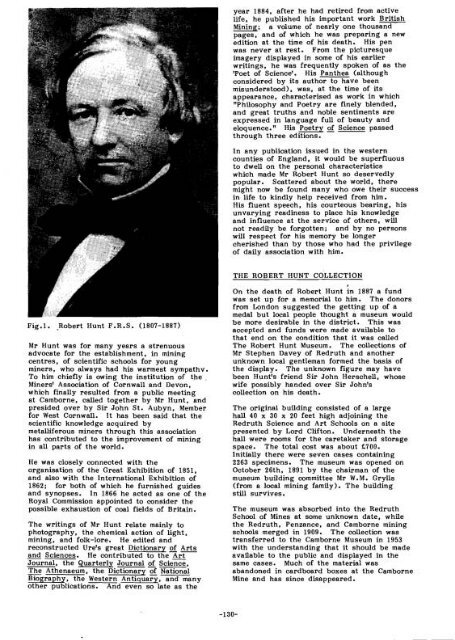Number 3 - Geological Curators Group
Number 3 - Geological Curators Group
Number 3 - Geological Curators Group
Create successful ePaper yourself
Turn your PDF publications into a flip-book with our unique Google optimized e-Paper software.
year 1884, after he had retired from activelife, he published his important work BritishMining; a volume of nearly one thousandpages, and of which he was preparing a newedition at the time of his death. His penwas never at rest. From the picturesqueimagery displayed in some of his earlierwritings, he was frequently spoken of as the'Poet of Science'. His Panthea (althoughconsidered by its author to have beenmisunderstood), was, at the time of itsappearance, characterised as work in which"Philosophy and Poetry are finely blended,and great truths and noble sentiments areexpressed in language full of beauty andeloquence. If His Poetry of Science passedthrough three editions.In any publication issued in the westerncounties of England, it would be superfluousto dwell on the personal characteristicswhich made Mr Robert Hunt so deservedlypopular. Scattered about the world, theremight now be found many who owe their succin life to kindly help received from him.His fluent speech, his courteous bearing, hisunvarying readiness to place his knowledgeand influence at the service of others, willnot readily be forgotten; and by no personswill respect for his memory be longercherished than by those who had the privilegof daily association with him.THE ROBERT HUNT COLLECTIONFig.1. .Robert Hunt F.R.S. (1807-1887)Mr Hunt was for many years a strenuousadvocate for the establishment, in miningcentres, of scientific schools for youngminers, who always had his warmest sympathv.To him chiefly is owing the institution of the ,Minersf Association of Cornwall and Devon,which finally resulted from a public meetingat Camborne, called together by Mr Hunt, andpresided over by Sir John St. Aubyn, Memberfor West Cornwall. It has been said that thescientific knowledge acquired bymetalliferous miners through this associationhas contributed to the improvement of miningin all parts of the world.He was closely connected with theorganisation of the Great Exhibition of 1851,and also with the International Exhibition of1862; for both of which he furnished guidesand synopses. In 1866 he acted as one of theRoyal Commission appointed to consider thepossible exhaustion of coal fields of Britain.The writings of Mr Hunt relate mainly tophotography, the chemical action of light.mining, and folk-lore. He edited andreconstructed Urefs great Dictionary of Artsand Sciences. He contributed to the ArtJournal, the Quarterly Journal of ~cieG.The Athenaeum, the Dictionary of NationalBiography, the Western Antiquary, and manyother publications. And even so late as theOn the death of Robert Hunt in 1887 a fundwas set up for a memorial to him. The donorfrom London suggested the getting up of amedal but local people thought a museum woulbe more desirabie in the district. This wasaccepted and funds were made available tothat end on the condition that it was calledThe Robert Hunt Museum. The collections ofMr Stephen Davey of Redruth and anotherunknown local gentleman formed the basis ofthe display. The unknown figure may havebeen Hunt's friend Sir John Herschell, whosewife possibly handed over Sir John'scollection on his death.The original building consisted of a largehall 40 X 30 X 20 feet high adjoining theRedruth Science and Art Schools on a sitepresented by Lord Clifton. Underneath thehall were rooms for the caretaker and storagespace. The total cost was about £700.Initially there were seven cases containing2263 specimens. The museum was opened onOctober 26th, 1891 by the chairman of themuseum building committee Mr W.M. Grylls(from a local mining family). The buildingstill survives.The museum was absorbed into the RedruthSchool of Mines at some unknown date, whilethe Redruth. Penzance, and Camborne miningschools merged in 1909. The collection wastransferred to the Camborne Museum in 1953with the understanding that it should be madeavailable to the public and displayed in thesame cases. Much of the material wasabandoned in cardboard boxes at the CamborneMine and has since disappeared.
















